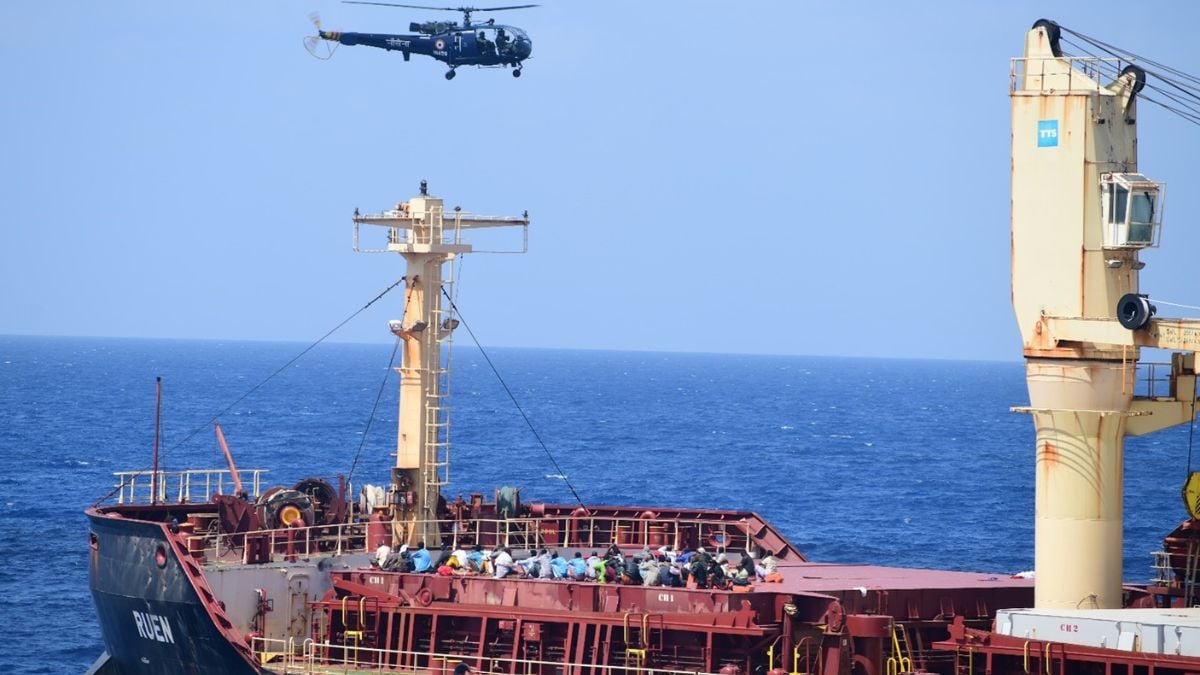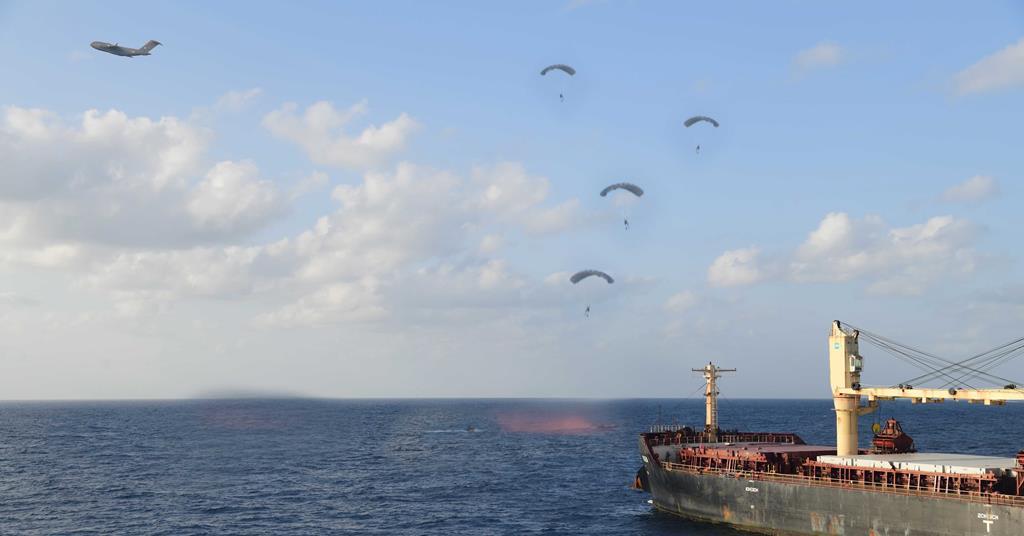Latest Thread
You are using an out of date browser. It may not display this or other websites correctly.
You should upgrade or use an alternative browser.
You should upgrade or use an alternative browser.

How Pirates Kick-Started India’s Navy Into Action
The Indian Navy has suddenly become the go-to security provider in the Indian Ocean—with big implications for both the U.S. and China.
How Pirates Kick-Started India’s Navy Into Action
The Indian Navy has suddenly become the go-to security provider in the Indian Ocean—with big implications for both the U.S. and China.
By Keith Johnson, a reporter at Foreign Policy covering geoeconomics and energy.
February 14, 2024, 11:54 AM
The unexpected and dramatic resurgence of piracy off the east coast of Africa has galvanized the Indian Navy into playing a dominant security role in one of the world’s critical waterways, with its biggest-ever naval deployment to the waters off Somalia in the last couple of months. India’s naval renaissance throws down a marker about its great-power ambitions—and sends a message to Beijing about how it will contest any challenge for dominance in the wider Indian Ocean region.
Pirates affiliated with the al-Shabab terror group in Somalia have suddenly taken again to the high seas after nearly a decade in which ship hijackings were in abeyance. Nearly 20 ships have been attacked, hijacked, boarded, or otherwise harassed in the waters of the Gulf of Aden since late November. Major shipping bodies had removed the area from the piracy high-risk designation just over a year ago.
“The piracy uptick is a puzzle, not just for India but for nations and navies around the world,” said Abhijit Singh, a former naval officer and the current head of the Maritime Policy Initiative at the Observer Research Foundation, a think tank in New Delhi.
The problem is that Somali pirates aren’t the only security headache in those waters: Since about the same time, Iran-backed Houthi rebels in Yemen have been attacking commercial ships in the constricted waters of the Red Sea, nominally as part of a campaign against Israel, causing widespread disruptions and diversions. Shipping container costs have basically doubled since the start of the dual campaign.
Since U.S. and U.K. naval vessels in the region have been trying to tackle the Houthi threat in the Red Sea, both by shielding transiting commercial ships and striking at Houthi targets on land, a security vacuum emerged in the Gulf of Aden, which the pirates were only too happy to fill—or try to. In response, the Indian Navy massively ramped up its deployment of large surface ships and aircraft to clamp down on pirates and backstop the otherwise busy Americans and British. India has increased its surface deployments from two ships to 12, all focused on that vulnerable stretch of the eastern Indian Ocean.
“If you look at the operational focus of the Western powers, it is much more on the Red Sea. You need naval powers like India to come and do constabulary services, and the kind of effort that India has put in—this is in some sense the largest deployment of the Indian Navy,” said Yogesh Joshi, an Indo-Pacific specialist at the National University of Singapore.
India’s naval flexing underscores how the country, long seen as a junior partner in the evolving security landscape of the Indo-Pacific region, is becoming a crucial component, with implications not just for short-term crises such as the piracy flare-up and protecting the global commons but also for the future balance of power in the Indian Ocean after years of Chinese efforts to leverage greater diplomatic and military presence in the region.
“It’s a combination of three factors: context, capacity, and commitment,” Joshi said. The international context has seldom been as favorable for India as it is now, with countries in the Middle East and the United States increasingly looking to New Delhi for partnerships. India’s capacity, especially its military and naval heft, has grown exponentially in recent decades, he noted. And the political commitment from Prime Minister Narendra Modi’s government has given new impetus to the kind of forward-leaning posture Indian admirals had sought for decades.
“The direction and clarity of purpose coming from the top is driving this extension of India’s security stance all over the Indian Ocean,” he said.
Of course, India is free to focus on the uptick in piracy precisely because it has avoided getting entangled in the problems with the Houthis and the Red Sea—much like how China, which for years has had a small anti-piracy deployment active off Somalia, has refused to play any role in protecting shipping under Houthi attack. India, like China, is leery of alienating any Middle Eastern countries that are big sources of energy. But that still leaves a vital role for New Delhi to play.
“A lot of trade has been hit by these [pirate] attacks,” Singh said. “There is the sense that the U.S. and others are busy with Operation Prosperity Guardian in the Red Sea, and so we must pick up the slack here in the Indian Ocean.”
Seems a team of MARCOS were para-dropped by C-17 @Kartal1 @Zapper
Indian Navy commandos forced the pirate ship to stop through calibrated actions which were augmented by INS Subhadra, HALE RPA, P8I maritime patrol aircraft & MARCOS PRAHARs air-dropped by C-17 aircraft

Indian Navy corners pirates, succesfully rescues 17 crew members onboard cargo ship
Indian Navy commandos forced the pirate ship to stop through calibrated actions which were augmented by INS Subhadra, HALE RPA, P8I maritime patrol aircraft & MARCOS PRAHARs air-dropped by C-17 aircraft
The Indian Navy, after a painstaking 40-hour-long operation, successfully rescued the 17 crew members of a Maltese-flagged merchant vessel on Saturday.
In a statement, the Navy said that it cornered and coerced all 35 Pirates to surrender while ensuring the safe evacuation of all the crew members of MV Ruen.
On Friday, the pirates opened fire on the Indian warship, which took appropriate actions in self-defence as per international law and to counter piracy and used minimal force to neutralise the pirates’ threat to shipping and seafarers.
How was the operation carried out?
INS Kolkata carried out the interception of the Pirate Ship Ruen almost 1400 nautical miles (2600km) from the Indian Coast.
As I stated before these operations will help MARCOS a lot. Did they really needed to para-drop them? I am not sure, but for one thing I am sure and that is the experience they will gain with these operations. To pull off an Airborne Assault within an exercise scenario is one thing and such a mission within a real operation and hostile environment with its unique challenges is totally different. Not long ago we heard about US Navy SEAL personnel who drowned in the region. While we don't know the exact circumstances, yet this is a clear sign about the dangers for the operational personnel in this kind of environment. I hope the Indian Navy continues with its successful interventions within their anti-piracy effort in the area and I hope they don't push the boys too far.Seems a team of MARCOS were para-dropped by C-17 @Kartal1 @Zapper
Indian Navy commandos forced the pirate ship to stop through calibrated actions which were augmented by INS Subhadra, HALE RPA, P8I maritime patrol aircraft & MARCOS PRAHARs air-dropped by C-17 aircraft

Indian Navy corners pirates, succesfully rescues 17 crew members onboard cargo ship
Indian Navy commandos forced the pirate ship to stop through calibrated actions which were augmented by INS Subhadra, HALE RPA, P8I maritime patrol aircraft & MARCOS PRAHARs air-dropped by C-17 aircraftwww.firstpost.com
The Indian Navy, after a painstaking 40-hour-long operation, successfully rescued the 17 crew members of a Maltese-flagged merchant vessel on Saturday.
In a statement, the Navy said that it cornered and coerced all 35 Pirates to surrender while ensuring the safe evacuation of all the crew members of MV Ruen.
On Friday, the pirates opened fire on the Indian warship, which took appropriate actions in self-defence as per international law and to counter piracy and used minimal force to neutralise the pirates’ threat to shipping and seafarers.
How was the operation carried out?
INS Kolkata carried out the interception of the Pirate Ship Ruen almost 1400 nautical miles (2600km) from the Indian Coast.
Even I wonder why they've been paradropped. The number of Marcos participating in this op was relatively higher than the previous ones since there were 30+ pirates onboard. Rappelling from a helo might've been a safer option but again we dunno the circumstances and not much details came out yetAs I stated before these operations will help MARCOS a lot. Did they really needed to para-drop them? I am not sure, but for one thing I am sure and that is the experience they will gain with these operations. To pull off an Airborne Assault within an exercise scenario is one thing and such a mission within a real operation and hostile environment with its unique challenges is totally different. Not long ago we heard about US Navy SEAL personnel who drowned in the region. While we don't know the exact circumstances, yet this is a clear sign about the dangers for the operational personnel in this kind of environment. I hope the Indian Navy continues with its successful interventions within their anti-piracy effort in the area and I hope they don't push the boys too far.
It seems like 2-3 teams entered via speedboats while another paradropped. Here's a few pics released by IN
Here's another videos of USN SBT airdropped along with their boats in the middle of the ocean which might explain how we were able to deploy more number of operators within immediately and possibly the Marcos wanted to test this strategy and operational effectiveness in real time scenario
and here we can see the pirate setries shooting at IN's chopper or possibly the surveillance drone
Last edited:
I'm sure they're loving it. With all their exercises and training with the SEALS & SBS, I heard they're itching to see actionI hope they don't push the boys too far
I think he's showing the pirates how to keep their hands
I think the retaking of the MV Ruen is the first Indian SOF op in recent times that got headlines across the world...
https://edition.cnn.com/2024/03/19/india/india-pirate-ship-capture-intl-hnk-ml/index.html

 www.flightglobal.com
www.flightglobal.com
https://edition.cnn.com/2024/03/19/india/india-pirate-ship-capture-intl-hnk-ml/index.html

Indian navy retakes hijacked cargo ship with C-17 commando airdrop
The operation to free a pirate-controlled bulk carrier ship involved marine commandos parachuting from a Boeing C-17 strategic transport, supplemented with reconnaissance support from a Boeing P-8 Poseidon maritime patrol jet.





